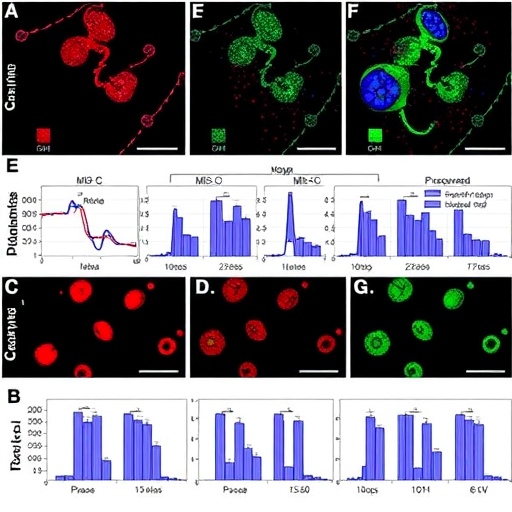Recent research has unveiled critical insights into the complex immunological responses invoked by multisystem inflammatory syndrome in children (MIS-C) and post-COVID-19 conditions. As the world continues to grapple with the ramifications of the COVID-19 pandemic, our understanding of the effects it has on pediatric populations, particularly concerning inflammatory disorders, becomes increasingly crucial. The landmark study, led by Roarty and colleagues, meticulously characterizes the proteomic alterations associated with these conditions, offering a window into the inflammatory pathways activated during these health crises.
In this groundbreaking analysis, the researchers employed advanced proteomic techniques to profile the proteins in children suffering from MIS-C and those recovering from COVID-19. The study underscores significant differences in protein expression patterns between these two groups. The findings indicate not only heightened inflammatory responses but also suggest the presence of biochemical footprints indicative of tissue damage. Such insights are essential for developing potential therapeutic strategies and enhancing clinical management for affected children.
The examination of the proteome in children with MIS-C revealed the activation of specific inflammatory pathways. Proteins known to play pivotal roles in the immune response, such as cytokines and chemokines, were found to be elevated. These proteins are crucial mediators in the immune system, and their overproduction is often linked to excessive inflammation and tissue injury. The study highlighted how this immune dysregulation may contribute to the severe manifestations observed in MIS-C patients, such as cardiac involvement and other systemic complications.
Furthermore, the research did not solely focus on MIS-C but also provided comparative insights into children who experienced post-COVID-19 symptoms. By elucidating the proteomic profiles of both cohorts, the researchers aimed to delineate the common and distinct pathways influenced by SARS-CoV-2 infection. The findings demonstrated that children recovering from COVID-19 exhibited different proteomic alterations compared to those diagnosed with MIS-C, indicating varying mechanisms of immune activation. Understanding these distinctions could enhance our strategies for clinical intervention and patient care.
In the arena of viral diseases, the role of proteomics has gained prominence as a powerful tool for uncovering pathological mechanisms. This study exemplifies how profiling protein expressions can uncover biomarkers that may serve as diagnostic tools for MIS-C and other post-viral syndromes. These biomarkers could facilitate early detection and timely interventions, potentially reducing the morbidities associated with prolonged inflammatory responses.
The therapeutic implications of this research extend to novel intervention strategies that could be devised based on the identified pathways. By targeting specific inflammatory mediators, researchers can explore pharmacological agents that might mitigate the systemic inflammation witnessed in MIS-C. Moreover, focusing on these pathways creates possibilities for developing personalized treatment regimens tailored to individual patients’ proteomic profiles.
In light of the observations made in this study, the authors propose a need for ongoing research into both MIS-C and post-COVID conditions. The complexities of these diseases, influenced by numerous factors including immune status, genetic predispositions, and environmental triggers, warrant detailed investigation. Future studies should also consider longitudinal tracking of proteomic changes as children recover from these conditions, fostering a deeper understanding of the long-term impacts of COVID-19 on the pediatric population.
In conclusion, the findings of Roarty et al. present a compelling narrative on the interplay between viral infections and inflammatory responses in children. By laying a strong foundation for future research, this study not only enhances our understanding of MIS-C and post-COVID-19 conditions but also paves the way for developing more effective treatment strategies tailored for children. Furthermore, ongoing collaborations across disciplines will be vital in addressing the multifaceted challenges posed by these syndromes and ensuring that young patients receive the best possible care.
As investigations into the impacts of COVID-19 continue to unfold, it becomes imperative that the scientific community remains vigilant in identifying and addressing the evolving challenges presented by these syndromes. The detailed proteomic characterization in this study is a significant contribution towards understanding the long-term consequences of SARS-CoV-2 infection on immune function, particularly in vulnerable populations such as children.
Prospective investigations will benefit from large-scale proteomic studies combining clinical parameters, genomic data, and patient histories. Integrating these diversified datasets will foster a holistic view of MIS-C and similar post-viral syndromes, influencing their management and creating a comprehensive knowledge base. As we move ahead, the urgency to better understand these conditions has never been more critical, which calls for concerted efforts from researchers, clinicians, and public health officials.
With the increasing incidence of MIS-C being observed globally, particularly in the post-vaccination era, this study heralds a pivotal moment in pediatric immunology. As science leaps forward, it is essential to maintain a focal point on synthesizing research outcomes into practical guidelines for clinicians confronting these complex inflammatory conditions. Engaging with findings like those of Roarty et al. will be integral to this mission, as the medical community strives to safeguard the health of children worldwide in the wake of the pandemic.
Ultimately, this study stands as a reminder of the intricate link between viral infections and immune dysregulation, particularly in the pediatric population. As ongoing research continues to decode the mysteries of these conditions, it becomes evident that a concerted effort is necessary to tailor interventions that can alleviate the burden of MIS-C and associated ailments effectively. The road to recovery for these young patients is paved with resilience and knowledge, underscoring the importance of scientific inquiry in unraveling the consequences of viral infections.
Subject of Research: Proteomic characterization of MIS-C and post-COVID-19 infection in children.
Article Title: In depth characterisation of the proteome of MIS-C and post COVID-19 infection in children reveals inflammatory pathway activation and evidence of tissue damage.
Article References:
Roarty, C., Tonry, C., McGinn, C. et al. In depth characterisation of the proteome of MIS-C and post COVID-19 infection in children reveals inflammatory pathway activation and evidence of tissue damage.
J Transl Med 23, 929 (2025). https://doi.org/10.1186/s12967-025-06826-3
Image Credits: AI Generated
DOI: 10.1186/s12967-025-06826-3
Keywords: MIS-C, COVID-19, proteomics, inflammation, pediatric health.




